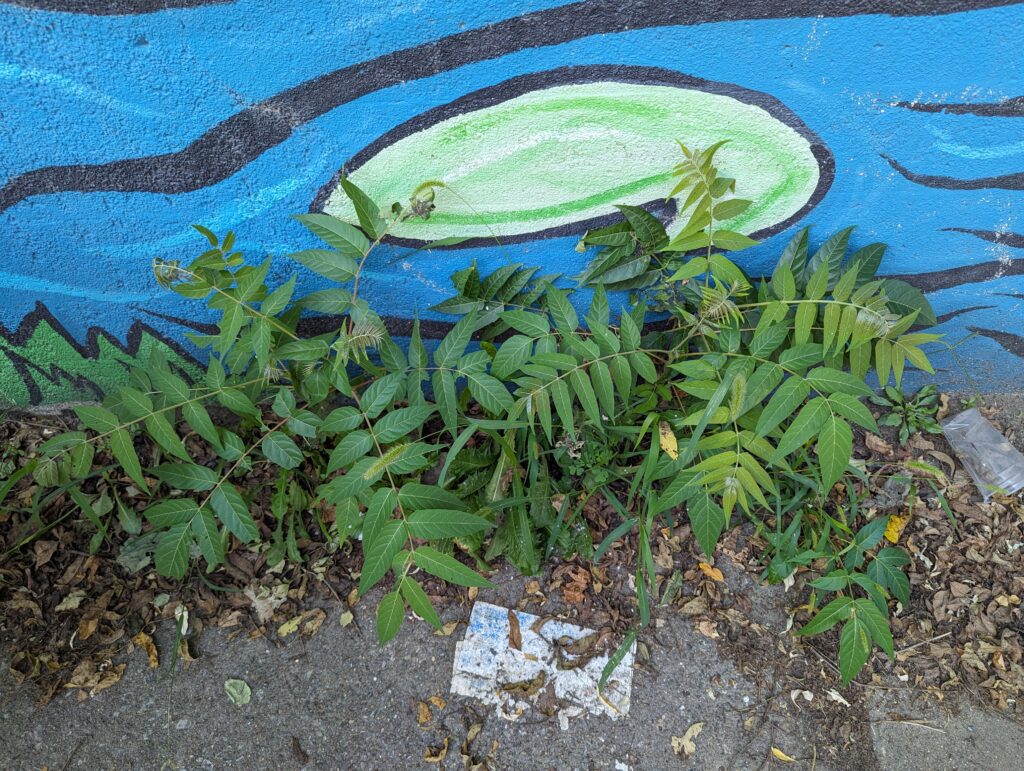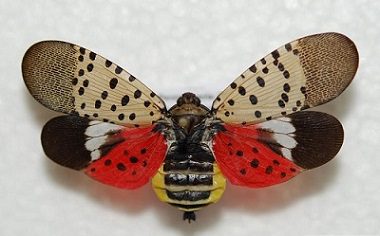Photo: Lawrence Barringer,
Pennsylvania Department of Agriculture, bugwood.org
My facebook feed has been filled in recent days with confirmed reports of Spotted lanternfly (Lycorma delicatula) in Elkhart, Porter and St. Joseph counties. Sadly, it is only a matter of time before it is confirmed in Marshall County. This is the third region of the state in which this invasive pest has been found, joining the 2021 find in Switzerland County (southeast) and the 2022 find in Huntington County (northeast).

Photo: Lawrence Barringer,
Pennsylvania Department of
Agriculture, bugwood.org
Spotted lanternfly is not a fly but rather a sap-feeding planthopper that originated in Asia. It was first discovered in the United States in Pennsylvania in 2014. The Pennsylvania Department of Agriculture tried to limit the spread of this pest, but unfortunately, it was not contained.

USDA-ARS Photo by Stephen Ausmus
Spotted lanternfly prefers to feed on Tree of Heaven (Ailanthus altissima), an invasive species, but it has been found on more than 103 species of plant including walnut, oak, maple, and various fruit trees. It is often found on grapevines in vineyards and can cause widespread damage. According to data provided by Penn State’s Extension, one vineyard in the United States experienced a staggering 90% reduction in yield as a result of spotted lanternflies.

Photo by Deb McCullough, MSU
Adult insects have piercing, sucking mouthparts and weaken the plants through feeding on them, which can make it difficult for the plant to survive the winter. In addition, as the immature nymphs and adults suck sap, they excrete honeydew, which coats the vegetation, sidewalks, driveways, and anything beneath the infested trees. Sugary honeydew attracts ants and wasps. Black sooty mold that grows on the honeydew is another unwelcome side effect of Spotted lanternfly.
Locating and managing Tree of Heaven is a key aspect of dealing with Spotted lanternfly.
Tree of Heaven, the main host for Spotted lanternfly, is one of the fastest growing trees in North America. Both the common name (Tree of Heaven) and the Latin genus (Ailanthus means “sky-tree”) refer to the tree’s ability to grow vertically. It can grow anywhere from 3′ – 10′ or more a year. Mature trees generally are 60 to 80 feet tall and can be 4 to 6 feet in diameter. Tree of Heaven grows just about anywhere its seed lands, in the poorest of soils, with very little water, and even out of cracks in cement. It also has a bad record for being allelopathic, preventing other plants from growing nearby.

More information about Tree of Heaven and Spotted lanternfly can be found here.
Suspected finds of Spotted lanternfly should be reported to the Indiana Department of Natural Resources. Call 866-NO EXOTIC (866-663-9684) or email DEPP@dnr.IN.gov.. Please leave your name, contact number and detailed information about what you are reporting.
Photos are always appreciated.

Hi, I’m Debbie Palmer. I received a BS in Horticulture from Purdue University. Here at LMEF, I am responsible for outreach presentations, monitoring the lake and it’s wetlands, project manager for restoration and research projects, and act as a community resource for all things related to the well-being of Lake Maxinkuckee and its surrounding watershed. I completed Indiana Watershed Leadership Academy, volunteer with the Indiana Clean Lakes Program, Hoosier River Watch and Marshall County Lakes and Waters and serve as a Board Member for Indiana Lakes Management Society.


Recent Comments